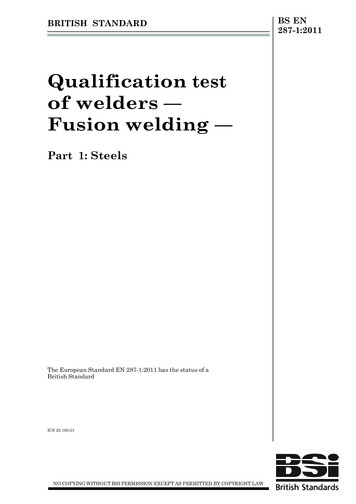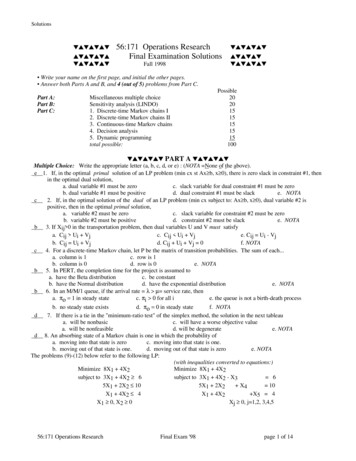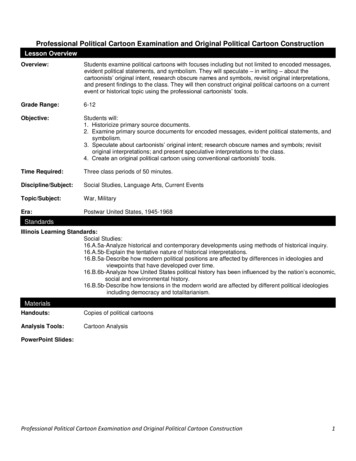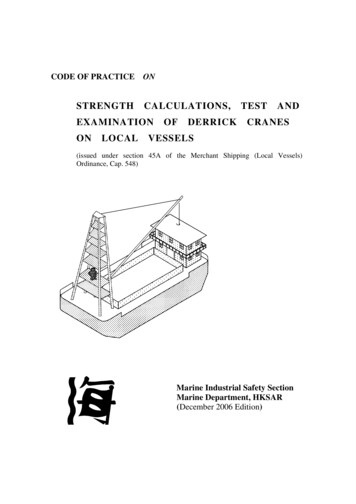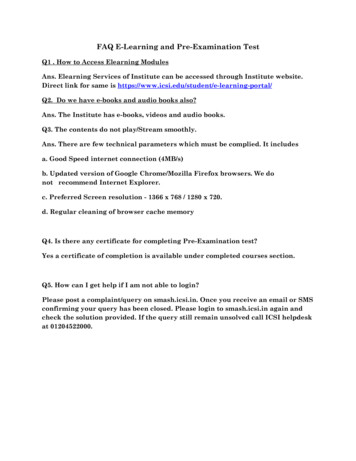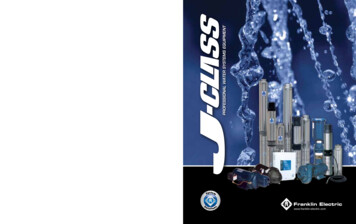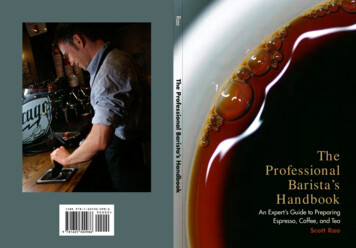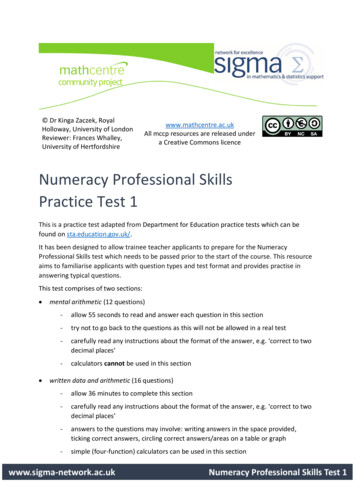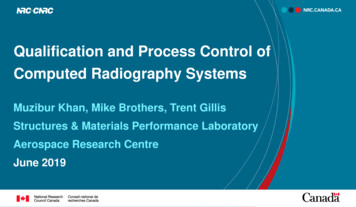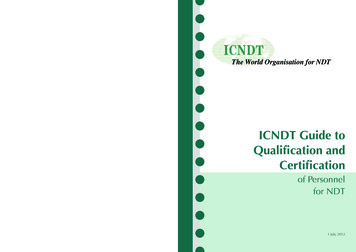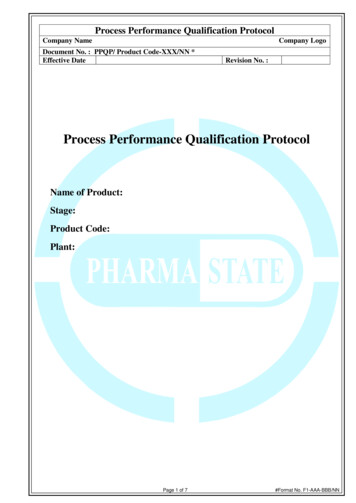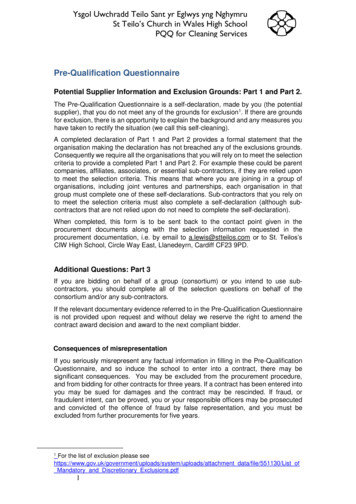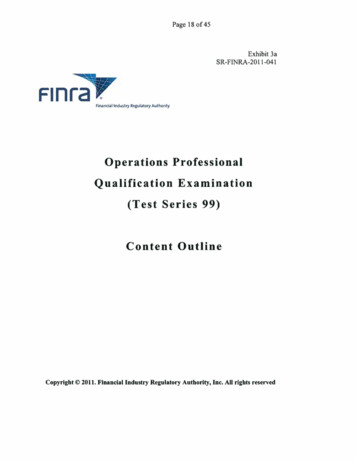
Transcription
Page 18 of 45Exhibit 3aSR-FINRA-2011-041Financial Industry Regulatory AuthorityOperations ProfessionalQualification Examination(Test Series 99)Content OutlineCopyright 2011. Financial Industry Regulatory Authority, Inc. All rights reserved
Page 19 of45Table of ContentsINTRODUCTION . . iiPURPOSE OF THE OPERATIONS PROFESSIONAL EXAMINATION . iiDEPTH OF KNOWLEDGE . .iiELIGIBILITY REQUIREMENTS . . iiiAPPLICATION PROCEDURES .iiiORGANIZATION OF THE CONTENT OUTLINE . . ;. iiiSTRUCTURE OF THE EXAMINATION . . . jvDEVELOPMENT AND MAINTENANCE OF THE CONTENT OUTLINE ANDEXAMINATION . . . . . ivTHE ADMINISTRATION OF THE EXAMINATION . . vHOW THE EXAMINATION IS SCORED .vCANDIDATES' TEST RESULTS . . vSAMPLE TEST QUESTIONS . vTHE OPERATIONS PROFESSIONAL CONTENT OUTLINE .1APPENDIXRULES AND REGULATIONS REFERENCES . . .A-lSAMPLE QUESTION TYPES . . . . B-1SAMPLE QUESTIONS. . . .B-2Outline Page i
Page 20 of45INTRODUCTIONThis content outline provides a comprehensive guide to the topics covered on the Financial Industry RegulatoryAuthority's (FINRA) Operations Professional Qualification Examination (Series 99). The outline is intended tofamiliarize candidates with the range of subjects covered on the examination, as well as the depth of knowledgerequired. In addition, a list of rules and regulations references that provide background for some of the definitionsand concepts being tested is provided. Sample questions are also included to acquaint candidates with theprincipal formats of multiple-choice questions used on the examination and the types of subject matter included inthe questions. It is recommended that candidates refer to the content outline as part of their preparatory studies.Candidates are responsible for planning their course of study in preparation for the examination.PURPOSE OF THE OPERATIONS PROFESSIONAL EXAMINATIONThe purpose of the Operations Professional Qualification Examination is to provide reasonable assurance thatcertain operations personnel associated with a FINRA member, "covered persons" as defined by FINRA Rule1230, understand their professional responsibilities, including key regulatory and control themes, as well as theimportance of identifying and escalating regulatory red flags that may harm a firm, its customers, the integrity ofthe marketplace and/or the public.The Operations Professional Qualification Examination is designed to assess a candidate's broad understandingand basic knowledge of: a broker-dealer's business at a fundamental level; the operations functions that support a broker-dealer's business; the regulations that are designed to achieve investor protection and market integrity; the regulations that drive operations processes and procedures conducted at a broker-dealer; and regulatory red flag issues and the ability to identify and escalate these issues to the appropriate persons withinthe member firm, and/or a regulatory body, if necessary.DEPTH OF KNOWLEDGEGiven the diversity ofjob functions covered under the Operations Professional registration category, theexamination will test candidates' knowledge at a basic level of understanding and application. For each sectionand subsection on the content outline, the candidate will be tested on the basic knowledge of the subject matter.This will include definitions of key terms, the basic characteristics of certain products and general conceptsassociated with certain standard business practices and rules. For example: under Section 1.2.1, a candidate will be expected to know the definition and basic characteristics of equitysecurities, but will not be expected to know the same level of detail about equity securities as a productspecialist or a representative selling equity securities to customers; under Section 2.3.3, a candidate will be expected to know the basic differences between restricted andcommon stock positions but will not be expected to know the process for removing restrictive legendsfrom a security.Outline Page ii
Page 21 of 45ELIGIBILITY REQUIREMENTSThe candidate must be sponsored by a FINRA member finn to be eligible to take the Series 99 Examination. Formore infonnation on eligibility requirements, please see FINRA Rule 1230(b)(6), which can be viewed throughthe following web link:htt d- 2403&record id- 13967&element id I 0208&APPLICATION PROCEDURESThe member finn that sponsors the candidate must file a Fonn U4, Unifonn Application for Securities IndustryRegistration or Transfer (Fonn U4) in the Central Registration Depository (Web CRD ), and request theOperations Professional position (OS) on the Fonn U4.ORGANIZATION OF THE CONTENT OUTLINEThe Operations Professional Content Outline includes three major content areas and an appendix of rules andregulations references that will be useful in gaining an understanding of the general concepts included in thecontent outline. An underlying component that is assessed in all three content areas is the ability to identif'y andappropriately address certain activities or practices that constitute a regulatory red flag and may hann a finn, itscustomers, the integrity of the marketplace and/or the public. Given this objective, ethical and best practice-basedquestions are associated with all three content areas. The content outline is organized as follows: Section 1: Basic Knowledge Associated witb tbe Securities Industry includes essential product andmarket knowledge for an operations professional, including definitions and characteristics of major productcategories and basic knowledge ofa broker-dealer' s business and the securities industry Section 2: Basic Knowledge Associated witb Broker-Dealer Operations includes broad-based knowledgeregarding the covered operations functions that support a broker-dealer's business Section 3: Professional Conduct and Etbical Considerations includes knowledge of associated personconduct rules, such as registration requirements, supervision and control, duties and conflicts, and dataintegrity Appendix: This section of the document includes: (1) Rules and Regulations References that provide aresource for learning and understanding the definition of terms, knowledge and concepts contained inSections I, 2 and 3, and (2) Sample Question Types and Sample QuestionsOutline Page iii
Page 22 of45STRUCTURE OF THE EXAMINATIONThe examination consists of 100 multiple-choice questions, which are distributed among the three major contentareas. The allocation of test questions for each major content area is listed in the table below.Number of Questions by Major Content AreaSectionMajor Content AreaNumber ofQuestionsIBasic Knowledge Associated with the Securities Industry322Basic Knowledge Associated with Broker-Dealer Operations483Professional Conduct and Ethical Considerations20TotallOaDEVELOPMENT AND MAINTENANCE OF THE CONTENT OUTLINE ANDEXAMINATIONThe content outline, test questions and the distribution of test questions were developed and validated by acommittee of industry representatives. The committee was comprised of industry professionals with extensiveexperience and oversight of the covered functions at FINRA member firms.To ensure and sustain the relevance of the examination, a committee of industry representatives writes, reviewsand validates all test questions under the guidance of FINRA staff. Test questions are subjected to multiplereviews prior to inclusion on the examination and each question is linked directly to a component of the contentoutline. Test questions vary in difficulty and complexity. Each question will have only one correct or bestanswer.The bank of test questions changes constantly as a result of amendments to, or the introduction of, governmentand/or industry rules and regulations, changes in practice and/or the introduction of new products. It is thecandidate's responsibility to keep abreast of such changes when preparing to take the examination. Test questionsand their statistical performance are analyzed routinely by FINRA staff and the committee to ensure that testquestions continue to be relevant to the Operations Professional. Test questions are updated when necessary toreflect current definitions and basic concepts related to industry practices and regulations. If industry practices,rules and/or regulations pertinent to the examination are amended or added, FINRA will republish the contentoutline at or around the time the industry practice changes or the amended rules and/or regulations becomeeffective.Outline Page iv
Page 23 of45THE ADMINISTRATION OF THE EXAMINATIONThe examination is administered via computer. A tutorial on how to take the examination is presented prior totaking the examination. Each candidate' s examination includes ten additional, unidentified pretest questions thatdo not contribute toward the candidate's score. The ten questions are randomly distributed throughout theexamination. Therefore, each candidate's examination consists of a total of 110 questions (100 scored and 10unscored). Each scored test question is worth one point. There is no penalty for guessing. Therefore, candidatesshould try to answer all questions. The appointment time for the examination will be 3 hours with 2.5 hoursprovided to complete the examination.Scratch paper and basic electronic calculators will be provided to candidates by the test center administrator andmust be returned to the test center administrator at the end of the testing session. Some test questions involvesimple calculations such as addition, subtraction, multiplication and division (Please refer to the Appendix forexamples of test questions involving a simple calculation). Only calculators provided by the test centeradministrators are allowed for use during the examination.Candidates will not be permitted to bring any reference material to their testing session. Severe penalties areimposed on candidates who cheat or attempt to cheat on FINRA-administered examinations.HOW THE EXAMINATION IS SCOREDThe passing score for the examination is the minimum number of test questions that a candidate has to answercorrectly to pass the examination. A committee of industry representatives using a standard setting procedureestablishes the passing score for the examination. The passing score is an absolute standard, and it is independentof the performance of candidates taking the examinations. The pass point for the examination taken by thecandidate will be indicated on the candidate's score report.CANDIDATES' TEST RESULTSCandidates will receive a score report of their test results both on screen and in paper format at the end of theirtest session. The score report will indicate pass/fail status, the total score and a score profile indicatingperformance based on each major content area covered on the examination. It is recommended that candidateswho fail the examination review the information provided on the score report, as they may want to focus on theareas in which they performed poorly when preparing to take the examination again. For security reasons, theexamination and/or individual test questions are not available for review after taking the examination.SAMPLE TEST QUESTIONSSample multiple-choice test questions are presented in the Appendix on pages B-1 - B-9. The sample questionsare included to provide examples of the basic types of multiple-choice test questions used in the examination.They also provide an illustration of the typical difficulty level of the actual test questions and the subject mattercovered on the examination.Outline Page v
Page 24 of45THE OPERATIONS PROFESSIONAL CONTENT OUTLINE1. Basic Knowledge Associated with the Securities Industry1.1 Purpose ofthe Marketplace Regulatory and self-regulatory organizations (SROs) Types of markets Depositories and clearing facilities1.2 Characteristics of Securities and Products Public securities offering versus private securities offering Initial public offering (lPO) versus secondary offering Exempt versus non-exempt securities Registered versus unregistered securities Priority of debtors' claims in bankruptcies Securities Investor Protection Corporation (SIPC) versus Federal Deposit Insurance Corporation (FDIC)1.2.1 Characteristics of the following products: Equities Debt/fixed income Derivatives Packaged securities/alternative investments1.3 Basic Knowledge ofthe Characteristics of Broker-Dealers Broker-dealer versus registered investment advisor (RIA) Suitability obligation Commissions/mark-ups versus fee-based Customer statement versus performance report1.3.1 Regulatory requirements of broker-dealers Financial and Operations Principal (FINOP) Financial and Operational Combined Uniform Single (FOCUS) report General ledger Net capital and the reserve formula calculation1.3.2 Types of broker-dealer businesses Executing broker-dealer versus clearing prime broker Introducing broker-dealer versus clearing broker-dealer Clearing broker-dealer versus clearing facility Institutional clearing and settlement arrangements Commission management/soft dollarsOutline Page I
Page 25 of452. Basic Knowledge Associated with Broker-Dealer Operations2.1 Basic Knowledge of Account Opening and Maintenance2.1.1 Types of retail, institutional and prime brokerage customer accounts Types of customer account registrations (e.g. , individual, corporate)2.1.2 Types of individual and employer-sponsored retirement accounts Contribution limits and required minimum distributions (RMD) Transfer versus rollover2.1.3 Account opening Entities authorized to open and transact business in the account New account paperwork and appropriate approvals Standing settlement instructions (SSIs)2.1.4 Anti-money laundering (AML) reviews AML compliance program Required customer information and documentation Customer Identification Program (CIP) requirements "Know Your Customer"(KYC) Office of Foreign Asset Control (OFAC) and the Specially Designated Nationals and Blocked Persons(SONs) list Financial Crimes Enforcement Network (FinCEN) Suspicious activity reports (SARs)2.1.5 Maintenance of accounts Escheatment process Updating customer account records Restricting account activity or freezing accounts Accounts for associated persons of member firms2.1.6 Types of disclosures Product specific disclosures (e.g., illiquid securities) Account specific disclosures (e.g. , options)2.2 Basic Knowledge of Cashiering and Account Transfers2.2.1 Movement offunds and securities Methods of fund transfer Methods of giving instructions (e.g., letter of authorization) Transfer processes for various account types Medallion signature guarantee program Currency Transaction Reports (CTRs) Reinvestments and sweepsOutline Page 2
Page 26 of452.2.2 Transfers or partial transfers of accounts between broker-dealers Automated Customer Account Transfer Service (ACATS) versus non-ACATS transfers Residual and residual credit processing2.2.3 Handling checks Characteristics of negotiable checks Check issuance Maintenance of a check blotter2.2.4 Prohibited activities related to cashiering and account transfers Structuring, layering and other money laundering activities Check kiting or altering checks Holding checks for extended periods Not processing (or holding) account transfers for an extended period2.3 Basic Knowledge of Custody and Control of Securities2.3.1 Custody and control of securities Safekeeping versus segregation Custody and control Street name Directly heid mutual fund shares Securing customer assets Periodic physical count of securities ("box count") Maintenance of a stock record and verifYing securities2.3.2 Securities transfers Registered versus bearer certificates Good delivery, transfer agent and stocklbond power Validation of a certificate Maintenance of a securities blotter Handling lost certificates Direct Registration System (DRS) and DepositlWithdrawal At Custodian (DW AC) Types of securities that are depository eligible2.3.3 Stock legends Impact of a legend on the negotiability of a certificate Control and restricted securities Holding periods for the removal of legends2.4. Basic Knowledge of Trade Reporting and Trade Corrections Trading orders and strategies: long and short, buy and sell, naked and covered, bearish and bullish Trade reporting systems Best execution, trading capacity and quotation Regular market hours versus extended hours Trader corrections "as/of' and past settlement dateOutline Page 3
Page 27 of45 Error accounts Knowledge of prohibited activities related to trading, including front-running, churning or excessivetrading, market manipulation, excessive mark-ups, prohibited breakpoint sales, and improper sharing inprofits and losses with customers2.5 Basic Knowledge of Corporate Actions2.5.1 Types of corporate actions Making adjustments for securities subject to corporate actions Processing customer instructions and special situations related to corporate actions Delivery of notices Corporate action deadlines2.5.2 Proxies and proxy voting Delivery of annual and interim issuer reports2.6 Basic Knowledge of Margin and Stock Loan/Securities Lending Margin, hypothecation and re-hypothecation Marginable versus non-marginable securities Different margin requirements for different securities Types of accounts that are pennitted to trade on margin Documentation and disclosure requirements Federal and FINRA margin requirements, margin calls Stock lending Short sale requirements, including locating and borrowing securities Day trading and buying power2.7 Basic Knowledge of Settlement Comparison of trades Same day versus regular way settlement Standard settlement time frames for various products Settlement service providers and methods of settlement Repo/resale trades and settlements Continuous Net Settlement (CNS) Don't Know (DK) trade Requirements to buy-in or closeout a fail Confinnation of aged securities fails2.8 Basic Knowledge of Account Statements and Confirmations2.8.1 Customer account statements Types of infonnation that appear on an account statement Time frame for providing statements2.8.2 Confirmations Types of information that appear on a confirmation Confinnation delivery requirements, including electronic confirmations Non-trade confinnations/third party activity noticesOutline Page 4
Page 28 of45 Prospectus delivery requirements2.8.3 Tax reporting Cost basis Types of optional and required tax withholding2.8.4 Prohibited activities related
a broker-dealer's business at a fundamental level; . reflect current definitions and basic concepts related to industry practices and regulations. If industry practices, rules and/or regulations pertinent to the examinati
